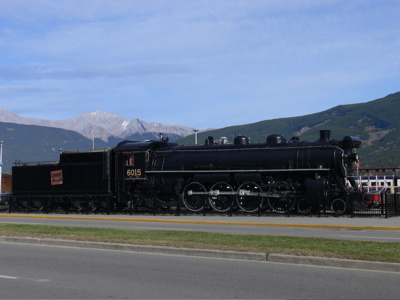 |
|
||||||||||||||
| Links to Notebook Pages: |
Monday October 09, 2006 6:15 am Edmonton
A. Morning Musings
6:15 am We will leave later this mornig for Jasper.
I am up-to-date with my Project Management link and will see if I can keep it that way. I will spend a little of the early morning with a fresh cuppa and the Fearless Symmetry book.
B. Plan
Immediate Health Walk & exercise 1 hr Birds Add September birds to North American data base 1 hr Mathematics Read & make notes for "Fearless Symmetry" chap 2 1 hr Later Chores Investigate water softeners for home Paint new bathroom vanity cabinet Technology add keywords to iPhoto records Read manual for cell phone Make notes for chap. 4 of "Switching to the Mac" Begin reading "iPhoto" digital photography - learn about using the various manual settings
Install MathType onto Word in Windows xp on the Mac Literature Read "The Art of Living" by Epictetus Read "The Song of Roland" Mathematics Larson "Calculus" Read "The Computational Beauty of Nature" Chap 3 Gardner "The Colossal Book of Short Puzzles" History Continue reading "Citizens" Watson "Ideas" Model Trains Continue wiring outer mainline Build oil refinery diorama: add ground cover Assemble second oil platform kit Puzzles The Orange Puzzle Cube: puzzle #9
C. Actual/Notes
6:40 am
6:40 am
Fearless Symmetry. Chapter 2 Groups [p. 13 - 20]
- "The definition of a group is the most common way mathematicians have of formalizing the concept of symmetry. " [p. 13]
- "A group is a set along with a rule that tells how to combine any two elements in the set to get another element in the set." [p. 14]
- "We usually use the word composition to describe the act of combining two elements of the group to get a third." [p. 14]
- "The key point about a group is the combination of any two elements to get a third." [p. 15]
- "DEFINITION: A group G is a set with a composition defined on pairs of elements, as long as three axioms hold true:
1. There is a neutral element e in G, so that x o e = e o x = x no matter what element of the group is substituted for x.
2. For any element x of G, there is some element y in G so that x o y = y o x = e (y is called the inverse of x)
3. For any three elements x, y, and z in G, we have (x o y) o z = x o (y o z). (this is called the associative law)." [p. 17]
- "DEFINITION: If G is a group, the group law is the rule that tells how to combine two elements in the group to get a third. We will usually write this combination as x o y, but occasionally as x + y or even xy." [p. 18]
- Groups that have infinitesimal generators are called continuous groups These are also known as Lie (pronounced lee) groups. Groups that have no smooth path from one element to another are called discrete groups.
- Continuous groups
- rotations of a sphere inside a cube with composition being successive rotations
- rigid motions in space
- rotations of a circle
- set of real numbers with composition given by ordinary addition.
- Discrete groups
- set of all integers with addition
- permutation group.
The idea of a group is an easy one. What is not quite so obvious is why this is a "good" idea. The connection between the concept of a group and that of symmetry is not yet obvious either.
The rest of this chapter is simply that of a few terms (group, composition, neutral element, inverse element) as well as notation (how to express the composition).
It is worth noting that there are many different "types" of group, each with different properties. The Lie groups are particularly interesting as they describe continuous compositions and are analogous to continuous functions in calculus.
The next chapter is about permutation groups, a special form of discrete group.
7:20 am
8:05 am
I have read chapter 3 Permutations [p. 21 - 30].
As with the previous chapter there is only one fundamental idea in the chapter, that of a permutation group. However there is some fairly complicated notation associated with this idea.
Fearless Symmetry. Chapter 3 Permutations [p. 21 - 30]
- "Permutation groups ... are essential for our later definition of Galois groups. Galois groups are permutation groups of a certain kind: they permute roots of polynomials." [p. 21]
- A permutation is a particular ordering of the elements of a given discrete set. A permutation group is the set of all possible orderings (i.e. each element of the group is a particular ordering).
- "The group of permutations of A is the set of functions from A to itself that are one-to-one correspondences. Composition of permutations are the composition of functions." [p. 25]
- "The neutral permutation e in a group of permutations of A is called the identity permutation." [p. 25]
- The permutations of a given set A are always a group, using composition to combine pairs of elements. We use the symbol sigma sub A to denote this group.
I am unable to easily type the symbol for sigma sub A using Dreamweaver. I think I will have to install MathType into the Windows version of Word and then use Parallels to switch between operating systems and use Grab to capture the image and paste it into this file.
- "One of the niftiest elementary things about a permutation is called its cycle decomposition." [p. 26]
7:00 PM We are staying at Amethyst Lodge in Jasper. It is a good feeling to be back on home turf. Seeing Mt. Edith Cavell down the valley brought back many memories.
I bought a great looking book, "Canadian national Steam. Vol. 2, Ontario & West. It has many photos of early steam locomotives in Jasper.
The weather forecast is beginning to look less appealing for tomorrow so we are thinking of heading all the way back to Lethbridge tomorrow. I am not sure if we will get an opportunity for any more photos.
D. Reflection






